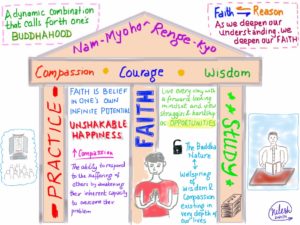
Some religions place primary emphasis on faith. Others strongly stress practice or acts of kindness. Some promote philosophical inquiry, while others discourage it, leaving such pursuits to religious professionals. Nichiren Buddhism encourages a dynamic balance of faith, practice and study.
Nichiren Daishonin writes: “Exert yourself in the two ways of practice and study. Without practice and study, there can be no Buddhism. You must not only persevere yourself; you must also teach others. Both practice and study arise from faith” (“The True Aspect of All Phenomena,” The Writings of Nichiren Daishonin, vol. 1, p. 386).
Faith
Faith in Buddhism is belief in our own vast potential and the limitless potential of all people to establish lives of unshakable happiness. This belief is expressed in the practice of chanting Nam-myoho-renge-kyo, the Mystic Law, the fundamental Law permeating our lives and the universe.
Nichiren Daishonin faced numerous persecutions and hardships in the course of establishing his teaching and triumphed in every instance. He inscribed the Gohonzon as an expression of his winning state of life, so that future generations could bring forth the same life condition (see pages 31–35). He writes, “I, Nichiren, have inscribed my life in sumi ink, so believe in the Gohonzon with your whole heart” (“Reply to Kyo’o,” WND-1, 412).
The basis of Nichiren Buddhist practice is believing deeply that chanting Nam-myoho-renge-kyo to the Gohonzon enables all people to reveal their innate Buddhahood. When we chant to the Gohonzon with faith, we fuse our lives with the Mystic Law and reveal the wisdom, courage, compassion and all that is necessary to overcome any hardship and to help those around us do the same. Nichiren tells us never to seek the Gohonzon or enlightenment outside our own lives (see “The Real Aspect of the Gohonzon,” WND-1, 832, and “On Attaining Buddhahood in This Lifetime,” WND-1, 3). Faith in the Gohonzon, therefore, means faith in the tremendous power and nobility inherent in our lives and the lives of others. Buddhist practice and study strengthen our faith. And the stronger our faith, the more benefit and growth will result from practice and study.
Practice for Oneself and Others
Faith often begins as a simple expectation of how Buddhism can help improve one’s life. With consistent practice, this expectation develops into conviction. Nichiren Buddhist practice consists of practice for oneself and practice for others. These are compared to the two wheels of a cart; both are necessary for the cart to move ahead properly.
Practice for oneself refers to chanting and reciting the sutra on a daily basis. We do this to bring about and maintain the high life
condition necessary to establish enduring happiness. Practice for others constitutes teaching people about Nam-myoho-renge-kyo and helping them establish their Buddhist practice and thereby create fulfilling lives. SGI activities aimed at further spreading Nichiren Buddhism and its humanistic philosophy are also part of this practice for others.
Nichiren writes, “Single-mindedly chant Nam-myoho-renge-kyo and urge others to do the same; that will remain as the only memory of your present life in this human world” (“Questions and Answers about Embracing the Lotus Sutra,” WND-1, 64). The happiness we create through chanting is eternal, transcending the boundaries of birth and death.
By chanting Nam-myoho-renge-kyo and teaching others, we break through the negativity that keeps us from becoming absolutely happy. When we practice consistently, we continue to strengthen and develop ourselves, paving the way for a joyful and rewarding life.
Study
Study in Nichiren Buddhism means reading Nichiren’s writings in order to correctly understand the Buddhist teachings and apply them more effectively in our lives. By deepening our knowledge of the teachings of Nichiren Buddhism, we strengthen our confidence and conviction and learn what it means to practice correctly. Nichiren states: “Both practice and study arise from faith. Teach others to the best of your ability” (“The True Aspect of All Phenomena,” WND-1, 386). By continually studying and seeking the correct Buddhist teaching, we can avoid the pitfall of forming shallow views based on personal opinion or the incorrect interpretations of others. To be misled by such things will prevent us from fully bringing forth our Buddha nature and enjoying the true benefit of our practice. Therefore, we also study the words and examples of the three
Soka Gakkai presidents—Tsunesaburo Makiguchi, Josei Toda and Daisaku Ikeda—who have fully applied and validated the teachings of the Daishonin in this modern age.
Second president Josei Toda once remarked, “Reason gives rise to faith; faith, in turn, seeks reason; reason thus gained elevates faith; and faith thus elevated further deepens reason.” In other words, as we deepen our understanding of Nichiren Buddhism, we can establish stronger faith. And with stronger faith, we will seek further understanding of Nichiren Buddhism.
In the course of our lives, we will certainly experience difficulties and at times may wonder, If I’m practicing Buddhism, why do I have this problem? As we deepen our faith through study, we come to see the opportunity within problems and obstacles and fortify our ability to overcome them. “Buddhist study,” President Ikeda says, “provides us with a great philosophy that serves as a compass to traverse the stormy and perilous seas of life. The more solid our foundation in Buddhist study, the stronger our faith will grow” (December 9, 2005, World Tribune, p. 2).
Through deepening our understanding of Nichiren Buddhism, we can resolve our doubts and continue toward establishing a state of unshakable happiness.
(Source: SGI-USA website)
